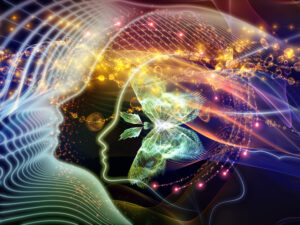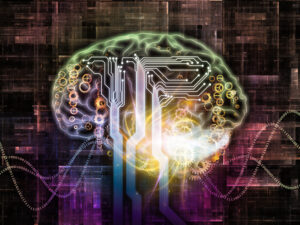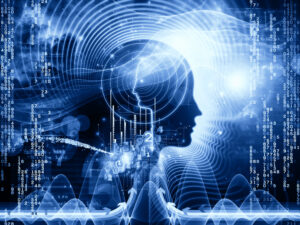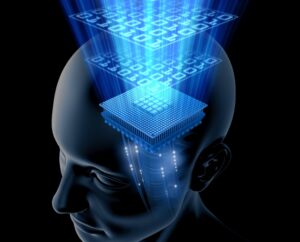The brain and consciousness are inextricably linked, meaning that shifts in one of these aspects of the self produce corresponding shifts in the other. This is in large part because consciousness is not restricted to existing only in physical form and is in fact a non-local field of energy which means that the brain is simply an organ which interfaces the mind with physical reality.
To draw an analogy, it is a translator of physical sensation and other experiential phenomenon from the body to the mind and from mind to the body. The brain allows the mind to control and move through the body, but the mind exists as an energetic field independently of the brain, which is why scientists have never been able to pinpoint consciousness to any specific part of the brain or to the brain itself—because it does not arise from the brain.
Metaphorically speaking, the brain is simply a tool that the non-local mind uses to interface with and experience physical reality.
With the brain being the primary organ through which consciousness experiences reality, its health and functioning affects our experience of consciousness in a significant way.
If our brain is undernourished, nutrient deficient, stressed out or in experiencing disharmonic brainwave patterns, our experience of consciousness in physical form (reality) will be diminished, which means that we’ll tend to experience more fear, anxiety, depression, stress, frustration, mental cloudiness and so on with a noticeable diminishment of higher, intuitive-transpersonal mental functioning, in other words, a shutting down of our higher intuitive abilities and spiritual awareness.
On the other hand, if our brain is nourished and relaxed with the two hemispheres operating in sync and harmony, our experience of reality will be exponentially improved (If you are interested, you can learn more about how consciousness interacts with reality here: the six phases of higher consciousness).
The Effects of Brainwave Patterns on Consciousness and the Experience of Reality
 The brain operates largely through electrical signals sent between approximately 100 billion neurons (nerve cells) spread out across different regions.
The brain operates largely through electrical signals sent between approximately 100 billion neurons (nerve cells) spread out across different regions.
The firing of these neurons happens rapidly and creates wavelike rhythms of activation and rest, which can be measured by sensitive machinery.
The rate at which the neurons fire and the synchronicity between the firing generates varying wave frequencies, which scientists have mapped, categorized and correlated to different states of consciousness as follows:
Alpha Waves: 8 Hz – 12 Hz
In the alpha wave state, you’ll most likely feel awake but also simultaneously quite relaxed and without a loss of brain function like you would if you were very tired. When you get up in the morning and just before you fall asleep, you are naturally in this state.
It’s interesting to note that when you close your eyes your brain naturally starts producing more alpha waves, however there are varying degrees of the alpha wave state and when you really drop in deep it’s far more powerful and profound than what you might feel or experience just from closing your eyes.
Deep alpha wave states are frequently seen in and experienced by meditators. Alpha activity also heightens your imagination, visualization, memory, learning and concentration and is correlated with a decrease in stress and anxiety.
Beta Waves: 12 Hz – 27 Hz
In the beta state you are essentially wide awake. Beta brainwaves are associated with normal waking consciousness and a heightened state of alertness, logic and critical reasoning. This is the dominant mental state most people are in during the day and the majority of their waking lives.
 Although this state tends to be uneventful, don’t underestimate its importance.
Although this state tends to be uneventful, don’t underestimate its importance.
Many people who lack sufficient beta activity may experience mental or emotional disorders such as depression or ADHD, and low SMR production (a sub-range of beta at 12-15 Hz) may be related to insomnia. While Beta brainwaves are important for effective functioning throughout the day, they also can translate into stress, anxiety and restlessness.
The voice of beta can be described as being that nagging little inner critic that gets louder the higher you go into the range.
On the other hand, stimulating beta waves in under active individuals can improve energy levels, concentration, attentiveness and emotional stability, however, most people notice more benefit from shifting their brainwaves into other less frequently experienced states such as alpha, delta, theta and gamma.
Delta Waves: 0.2 Hz – 3 Hz
Delta is the slowest band of brainwaves and is experienced in deep, Stage 4, dreamless sleep. When your brain is in a full delta wave state, your body is healing and repairing itself and resetting its internal clocks. You don’t actually dream in this state and are more or less completely unconscious. Delta has also been seen in very deep states of meditation as well.
Gamma Waves: 27 Hz and up
The Gamma wave state is associated with expanded awareness, creativity, activation of the pineal gland, heightened intuition, enhanced mental clarity and focus, deep feelings of peace, joy and oneness, formation of ideas, language and memory processing, and various types of learning.
As such, this is generally a highly desirable state to be in.
Unsurprisingly, Gamma waves have been identified as a characteristic brainwave pattern of regular meditators and monks and are present when we are dreaming, although they can arise in normal waking consciousness as well.
However, research has shown that by practicing forms of meditation and mindfulness regularly, you can literally rewire your brain to experience Gamma waves more frequently.
Theta Waves: 3 Hz – 8 Hz
Theta brainwaves are present during deep meditation, relaxation and light sleep, including the dream state. Theta has been shown to be a very receptive brainwave state that has proven useful for hypnotherapy, as well as self-hypnosis using recorded affirmations and suggestions. They are also strongly correlated with bursts of creativity, inspiration and vivid daydreams and visualizations.

According to brainwave experts, it is at the Alpha-Theta border, from 7 Hz to 8 Hz, where the optimal range for visualization, mind programming and using the creative power of your mind begins.
Clearly there are great benefits to be had by shifting your brainwaves into highly specific states, allowing your consciousness to experience reality through different ‘lenses’ that help it focus in positive, expansive and often times deeply healing ways.
The exercises, technologies and nutraceuticals below have all been proven to shift brainwave patterns and improve trans-hemispheric communication in the brain, allowing for an expanded experience of consciousness.
They are a blend of both organic, ancient practices and more modern technological advances, allowing you to blend the best of both worlds to your liking and suit your specific needs.
By: Justin Faerman


Okay, and what is the dangerous television induced wave range that lulls us into easily programmable couch potatoes?
Television works slightly differently, the fact that there is zero interaction with whats going on in the program or movie leads to an audit state in where a response is not required from the viewer. This causes lack of productivity and creativity as it becomes unneeded from the viewer, this state of viewing can potentially follow people around in day to day life and lead to less thought out responses. In conclusion, couch potatoes are still people, don’t lose hope in them and encourage them to partake in more interactive scenarios.